A Private Tour today in North Norfolk. It was a lovely sunny day and pleasantly warm in the fresh westerly wind (which meant it was thankfully not as swelteringly hot as yesterday!).
After meeting up, we made our way west along the coast road to Holme. As we parked and got out of the minibus, a family of Sedge Warblers was feeding in the low reeds opposite. The male did a couple of short song flights and the young ones were calling to be fed. We got a good look at their bold pale superciliums. A Cetti’s Warbler shouted at us from the bushes nearby and a Common Whitethroat was singing further back.
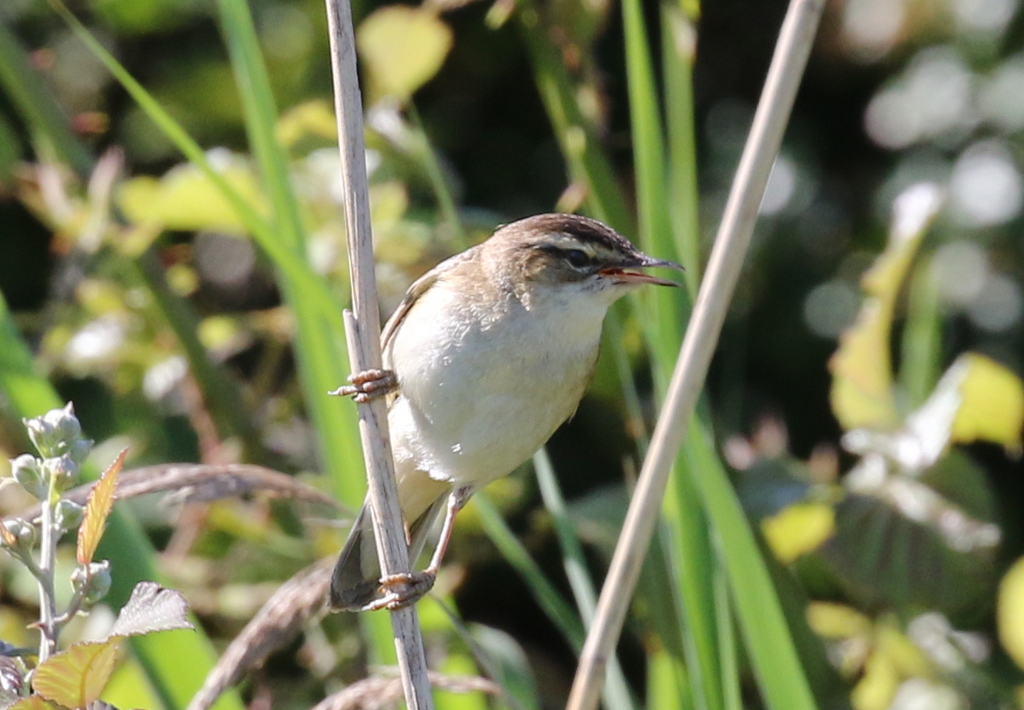
A Common Cuckoo flew across over the grazing marsh just beyond the reeds and disappeared over the entrance track into the dunes. It might have been a female, because it wasn’t calling – this was the first day we haven’t heard them here in the last few weeks. Some have already gone, but the remaining adults will be heading off soon on their way back south, leaving the surrogate parents to raise the young.
A couple of juvenile Marsh Harriers came up out of the bushes in the middle of the grazing marsh and flew round, exercising. When they landed back in the bushes, we got one of them in the scope – we could see its tawny orange head contrasting with its dark chocolate brown body.
Up on the seawall, a small number of Common Swifts was on the move, heading west low over the dunes. As one group came right past us, we could see their scythe shaped wings and dark, cigar-shaped bodies. A trickle of Swallows was moving through too this morning.
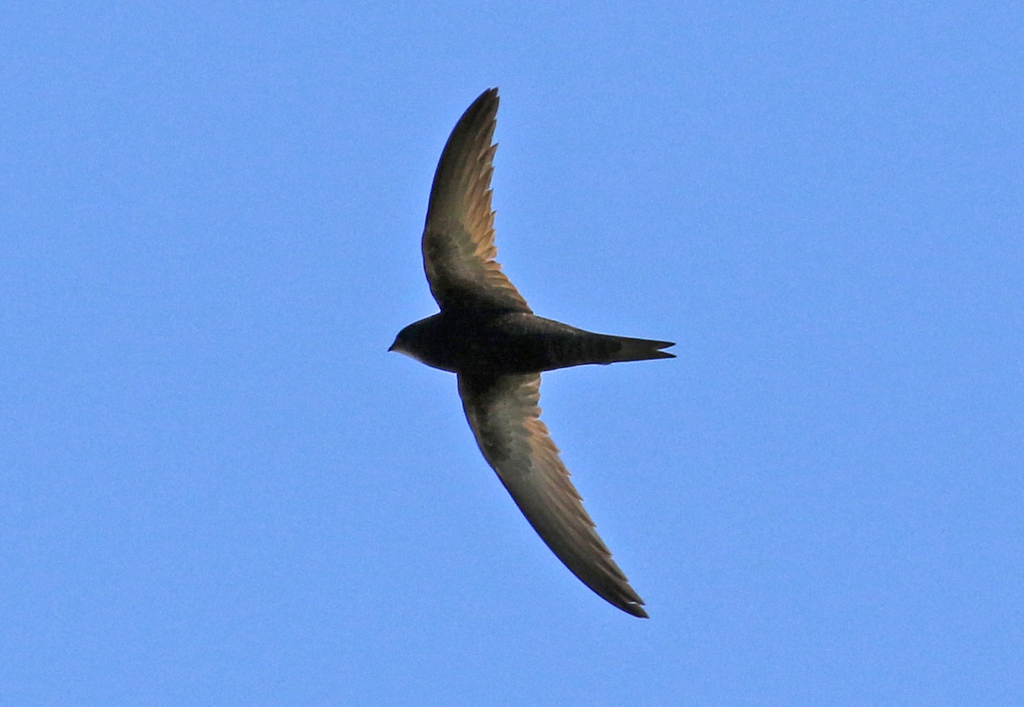
A large flock of Starlings flew up from the saltmarsh and whirled round before dropping down again. These are post-breeding gatherings of mainly juveniles here at this time of year, good to see that some are still breeding successfully. A Kestrel was hovering out over the saltmarsh too. As we made our way out towards the beach, we could hear Meadow Pipits singing in the dunes. We watched them fluttering up, rather like a Skylark initially but not going as high and without the melodic song, before parachuting back down again.
Out at the beach, the tide was out. There were several Curlews down on the exposed mud, at least a dozen. Like many waders, they are returning already from their breeding grounds on the continent. One summer plumage Bar-tailed Godwit, with its rusty underparts extending right down under the tail, was feeding in the shallow water nearby and there were lots of Oystercatchers too. Several Great Black-backed and Herring Gulls were loafing on the shore and a steady procession of Sandwich Terns flew past out over the sea.
We had seen a couple of Little Terns in the distance over the beach as we walked out. As we made our way along the sand, one came up from the cordoned off area by the dunes and circled over us calling. We weren’t close to the rope, but we backed off a discrete distance and it landed again so we could get it in the scope. We could see its black-tipped yellow bill and white forehead. The pair then turned their attention on an Oystercatcher which was walking over the shingle nearby, flying over it calling.
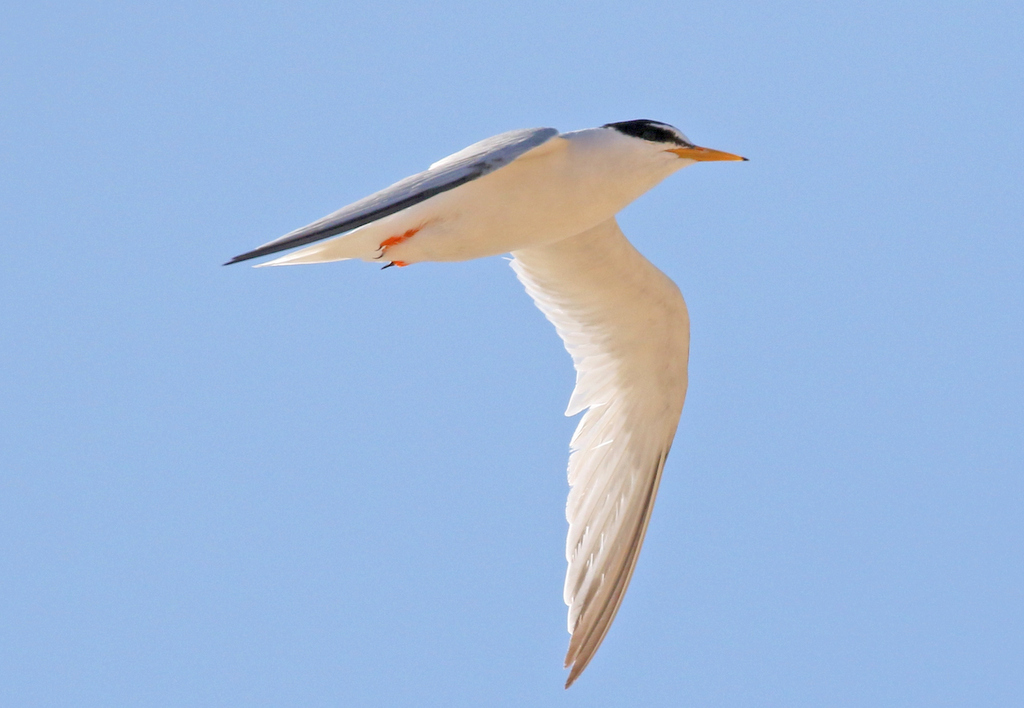
A little further on, we could see a small roped-off area outside of the main cordon. Sure enough, a Ringed Plover had chosen to nest outside the protected area and had to be provided with a fence all of its own. It was very well camouflaged but through the scope we could see its black and white ringed head and black-tipped orange bill. An adult Mediterranean Gull flew past over the dunes, its white wing tips translucent against the bright sky.
As we walked back through the dunes, a couple of Skylarks flew up from the grass. We saw the white trailing edge to their wings as they landed again. We stopped to admire some Cinnabar moth caterpillars on the ragwort, brightly striped yellow and black to warn any potential predators that they are unpalatable, having absorbed toxic chemicals from the plants on which they feed. A little further on, we spotted a Bee Orchid growing by the edge of the path.
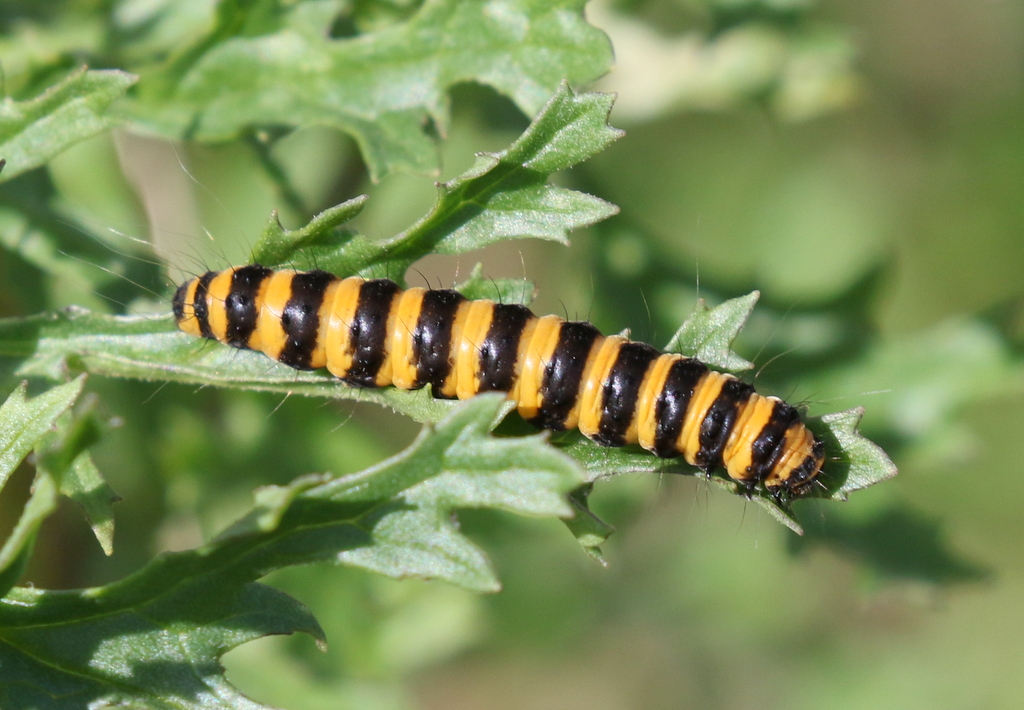
It was rather breezy up on the seawall. As we walked down towards the old paddocks, we could see a couple of Shelducks and one or two Avocets on the pools out on the saltmarsh. A Redshank flew up from one of the channels calling and a Curlew stood up on the vegetation looking round. A Little Egret flew past and dropped down out of view into another channel.
The paddocks were rather quiet at first, perhaps due to the breeze, but as we got down towards the golf course we heard a Turtle Dove purring in the bushes. We stopped to listen to it and it purred a couple more times, but then it went quiet before we could work out where it was. A couple of Common Whitethroats were singing here and we had a good view of them perched up on the top of the brambles. A Lesser Whitethroat flew past but typically disappeared into the bushes. Several Linnets were flying round calling and we got a good look at a smart male sporting a bright red breast.
After making our way back to the minibus, we headed round to Titchwell next. We still had a bit of time before lunch, so we decided to walk out to Patsy’s Reedbed first. On our way down to the Visitor Centre, a Blackcap was singing from deep in the sallows. A mixed flock of Long-tailed Tits and other tits was feeding in the trees and on the roof of the buildings behind the Visitor Centre and for some reason known only to it, a Song Thrush chased a Chaffinch through the bushes.
Round the other side, at the start of Fen Trail, we bumped into the tit flock again. We noticed a Chiffchaff with them too this time. A little further on and a Red Kite flew lazily over the trees just above our heads. A Reed Bunting was singing from the top of a bush out in the reeds just beyond Fen Hide.
From the screen overlooking Patsy’s, we could see a couple of juvenile Marsh Harriers up over the reedbed. Like the other ones we had seen at Holme this morning, they seemed to getting some exercise, and some practice in. A few Common Swifts and House Martins were feeding over the pool.
There were plenty of ducks on Patsy’s, mostly Mallard and Gadwall. The drakes are already mostly in drab eclipse plumage, looking rather more like females. Two female Common Pochard both were accompanying their ducklings, one with just one but the other with five. They are a rare breeder here, so it is always good to see them breeding successfully. There was no sign of any Red-crested Pochard on here today though. A female Tufted Duck was busy diving, a Great Crested Grebe was snorkelling right at the back, and a smart summer plumage Little Grebe drew admiring glances right down at the front.
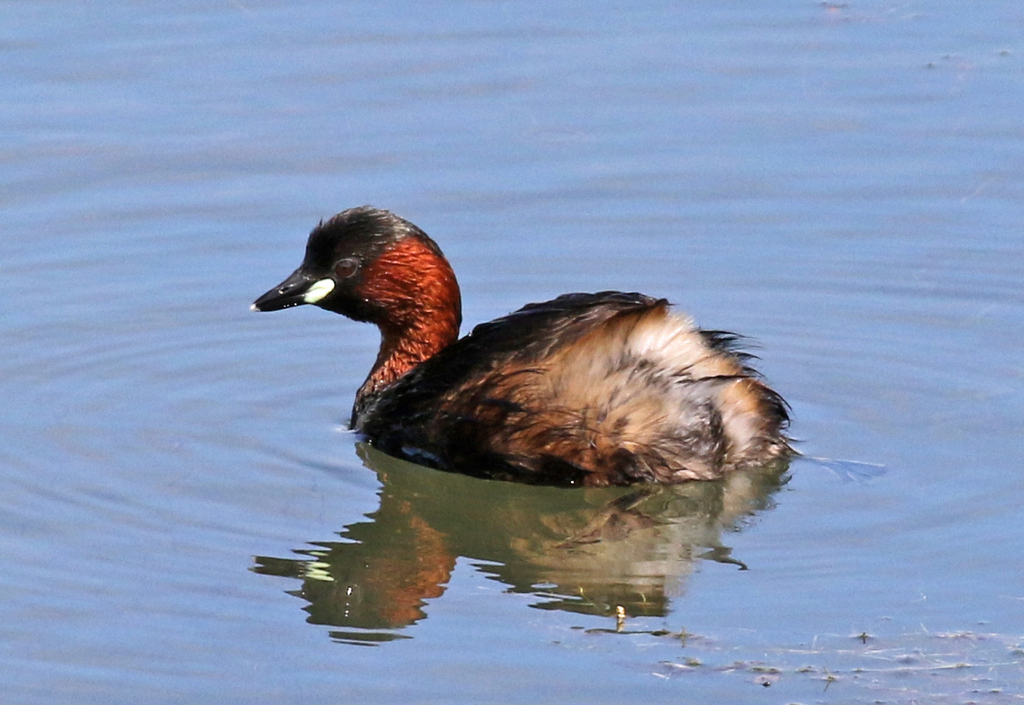
We went back for lunch in the picnic area and afterwards, headed out to explore the main part of the reserve. As we walked out past the reedbed, a Sedge Warbler was singing in the sallows and a couple of Reed Warblers were flitting around the edges of the pools below the bank. It was probably a bit too windy for Bearded Tits here though. A few of the commoner ducks were out on the reedbed pool and a male Marsh Harrier flew towards us over the reeds, before circling up into the blue sky.
We stopped in at Island Hide to have a look at the Freshmarsh. There are lots of Avocets on here now. An adult and a well-grown, brown-backed juvenile were feeding on the mud in front of the hide, presumably local birds, but lots more were loafing on the islands further back. Many will have come here to moult, and lots have arrived in the last few days, with recent counts of well over 300.
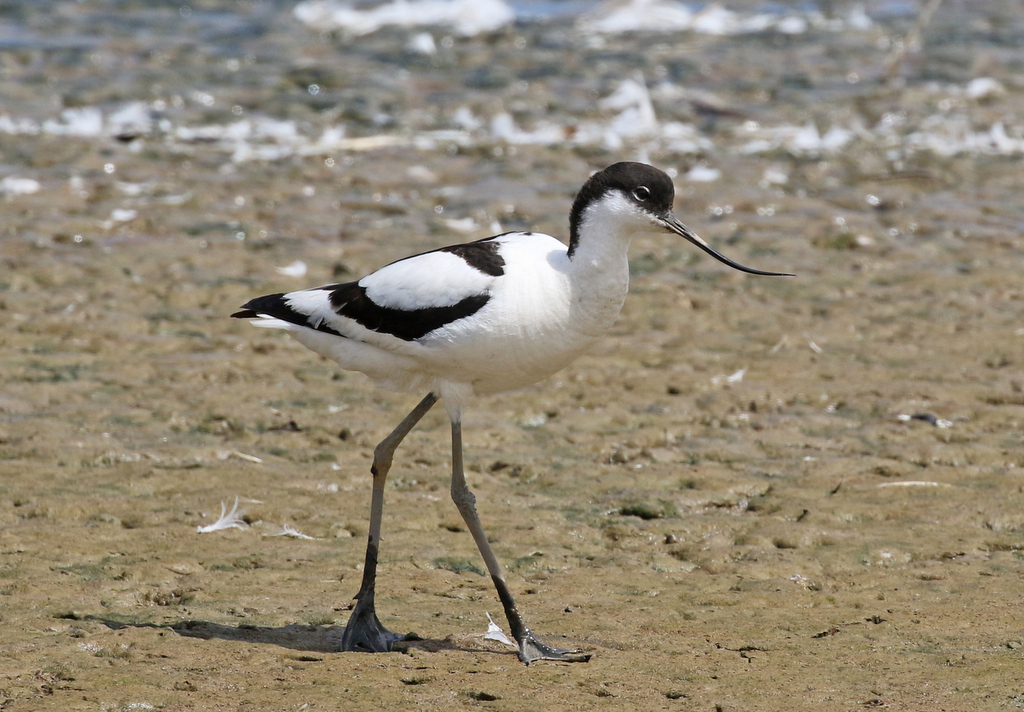
There was a nice selection of godwits out here today – both Black-tailed Godwits and Bar-tailed Godwits. Several were still in their bright rusty breeding plumage, the colour on the Black-tailed Godwits stopping half way down, with a black-barred white belly. A small group of Knot was feeding in amongst them, coming barely up to their knees. Most of them were in grey non-breeding plumage, but one or two were brighter orange still. Five Dunlin, still sporting their black-bellied breeding plumage, were feeding in the shallow water nearby.

The male Ruff are also starting to return already, having finished their breeding duties and left the females to incubate the eggs and raise the young. There were several moulting males out here today, in a bewildering variety of different plumages. No two were alike! Most had already lost their ornate ruffs and had rather scruffy necks, but one was still carrying most of its ruff. Similarly the Lapwings are losing their crests already.
The early returning Spotted Redshanks are generally females – unlike the Ruff, they leave the males to tend to the young. There were six out on the freshmarsh today, still in mostly in their striking black breeding plumage. Very smart-looking birds! There were several Common Redshanks too, but no sign of the Lesser Yellowlegs which had (re?)appeared yesterday. It had been seen earlier in the morning, but had flown off when something had spooked all the birds on the Freshmarsh and not returned.

The breeding season for the gulls is gradually coming to an end and there seemed to be much fewer still nesting now on the fenced off ‘Avocet Island’. There are still plenty here though, with lots sleeping on the islands out in the middle. We managed to find one or two adult Mediterranean Gulls still, easy to pick out with their jet black hoods, compared to the (ironically!) chocolate brown heads of the so-called Black-headed Gulls. A couple of scaly grey juvenile Mediterranean Gulls looked very different from the brown juvenile Black-headed Gulls. There were two or three Common Terns out with them too.
It is not really the time of year for looking at ducks, but numbers of Teal are steadily increasing now as birds return from the continent after the breeding season. A flock of Shoveler whirled round and dropped back down on the water over the back. There were a few Shelducks as usual.
The edge of the reeds from Island Hide is often a good place to look for young Bearded Tits in summer and we were not disappointed today. Two rather tawny-brown juveniles, with black lores and black mantles, worked their way round in and out of the bottom of the reeds, giving us a great look at them through the scope.

There were more waders in front of Parrinder Hide, Avocets, Black-tailed Godwits and a rusty male Ruff. A total of six Little Ringed Plovers were down on the muddy edge just to the left of the hide, looking very nervous – unusual to see so many together here. Five adults were standing in a group, where we could get a really good look at their golden-yellow eye rings, and a single juvenile was tucked in below the edge of the reeds nearby.
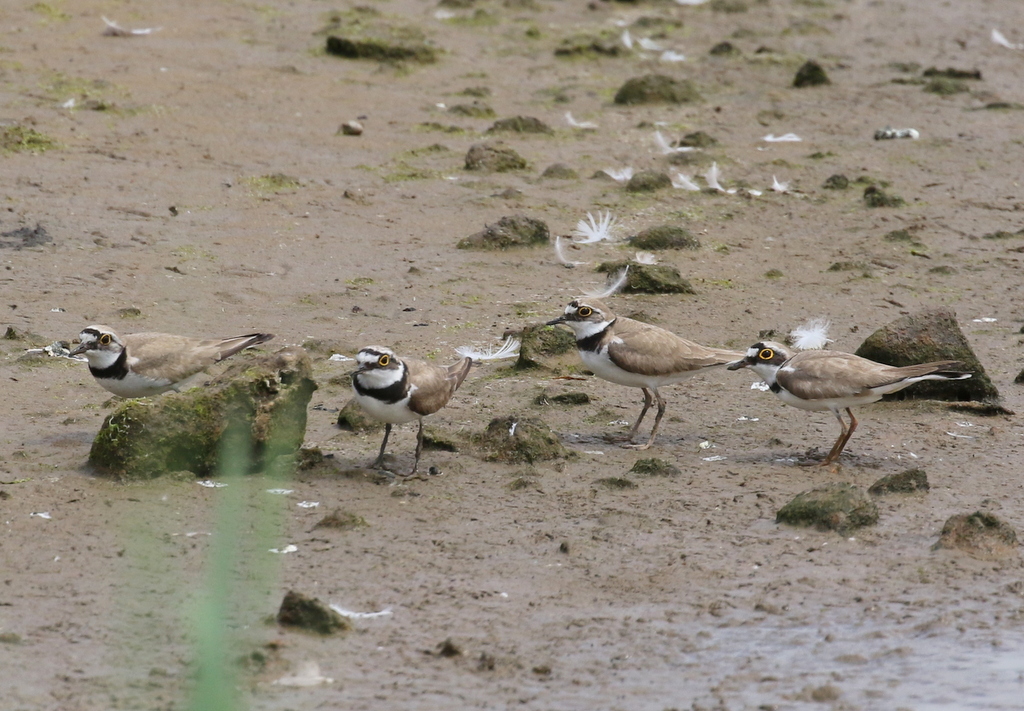
Then suddenly, as if by magic, the Lesser Yellowlegs appeared. It flew in and landed with the godwits out in the middle. We got the scope on it and could see its yellow legs. It was a very distinctive shape, long-legged and long-winged, distinctly elegant. At one point it was feeding together with a Common Redshank and was noticeably smaller and slimmer, with a finer bill, as well as having different coloured legs!

The Lesser Yellowlegs caused some noticeable excitement in the hide. It is a very scarce visitor to the UK from North America – it should be migrating down to South America not Norfolk! Interestingly, one turned up here last year in mid-July and stayed for several weeks. It seems very likely that this may be the same bird, which is now migrating north and south, but on the wrong side of the Atlantic.
All the birds on the Freshmarsh were very nervous, partly as the young Marsh Harriers had been working up and down over the banks during the afternoon. Suddenly everything spooked more than usual, and we looked out of the hide to catch a glimpse of a Hobby as it zipped past.
We had one more place we wanted to visit this afternoon, so we made our way back. A Common Lizard was basking on the fence by the path to Island Hide as we passed. We stopped for a quick look at the reedbed pool, where a couple of drake Red-crested Pochard were swimming in and out of the reeds at the back. One was already in eclipse and the other was looking rather tatty, but their bright coral red bills really stood out.
When three juvenile Marsh Harriers started to circle together, we realised the male was coming in with food for them. It circled above and as the youngsters gathered below, it dropped whatever it had been carrying. One of the juveniles went to catch it but missed as the others homed in on it too. As it dropped towards the reeds, another two juveniles raced in too. We didn’t see if one of them managed to get it. The juveniles landed again in the bushes and we had a look at one of them in the scope – much darker-headed than the ones we had seen at Holme earlier, with just a small tawny patch on the back of the neck.
Our last stop was back at Wells. As soon as we got out of the minibus, we could see six Spoonbills at the back of the pools. Two were adults, with longer yellow-tipped black bills, but the other four were recently fledged juveniles with shorter, not yet fully grown, fleshy-coloured bills – ‘teaspoonbills’.
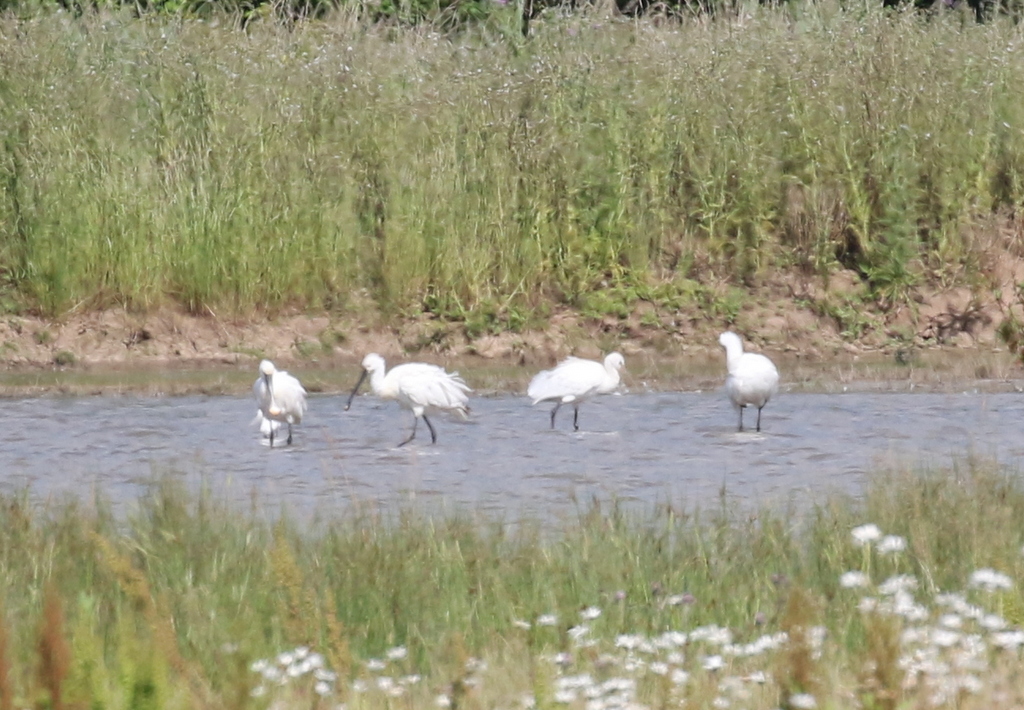
At least those Spoonbills were awake. We realised that there were more in the vegetation on one of the islands, doing what Spoonbills seem to like doing best, sleeping! The original six walked over to join them, and some of them woke up. A couple of the juveniles then decided they were hungry and started begging their parents for food, walking after them, bobbing their heads up and down, flapping their wings. Relentlessly!
There were several Little Egrets asleep in with the dozing birds too, more white blobs in the grass, so it was hard to count exactly how many Spoonbills there were in the vegetation. When most of them put their heads up at one point, we counted at least 18. It is the time of year when they gather on the coast, the young creched at convenient pools close to where the adults like to feed out in the saltmarsh channels. It was getting on for high tide now, which is why they were all loafing around.
Over the other side of the track, we found a Greenshank roosting in with the Redshanks. There were several young Avocets still, and adult birds not too far away which were presumably their parents, although their childcare skills leave much to be desired. A group of Black-tailed Godwits was feeding down in the front corner.
A Marsh Harrier flew in and circled over the wheat field beyond. It was a female with green wing tags. It seemed to be after the Woodpigeons, and kept stooping down towards the crop, but the pigeons just flew off and it never really got close. Two adult Common Gulls flew in but landed out of view at the back of the pools. They are not exactly common here at this time of year. Then it was time to finish and head back.
















